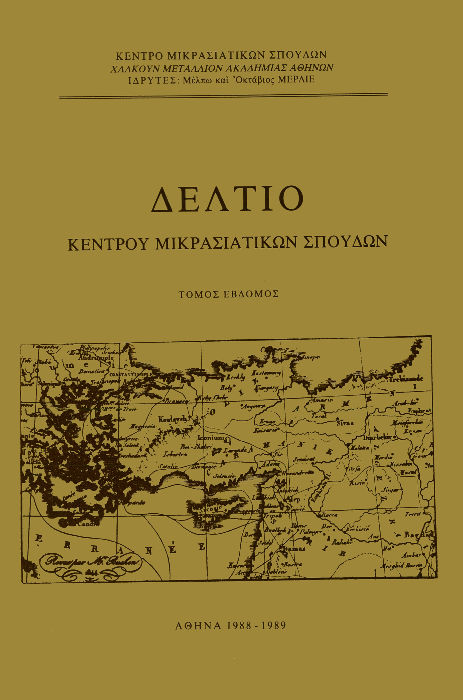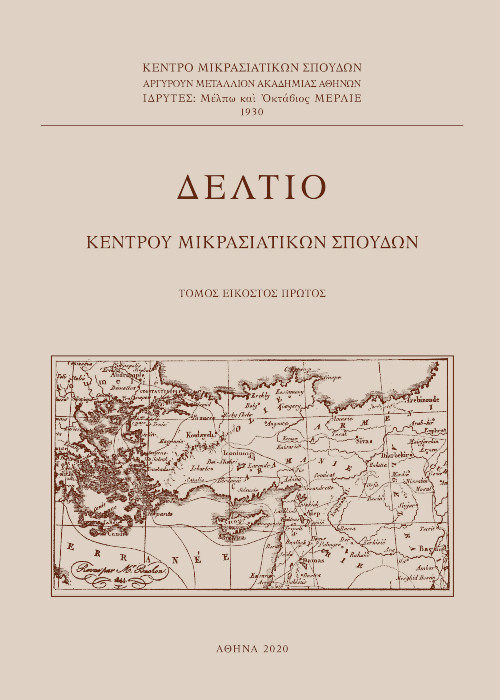Εκκλησιαστικά ασημικά από την Κωνσταντινούπολη και ο πατριαρχικός θρόνος του Ιερεμία Β'
Περίληψη
16th century Orthodox liturgical silver displays a hybrid Christian-Islamic
character exemplified in the persistence of the Byzantine iconographie tradition,
in the use of western European shapes and techniques, and in the
adoption of Ottoman decorative styles. Two characteristic examples of this
hybrid style are a bowl stamped with the tugra of Bayezid the II (fig. 1) and
a jug with animal decoration and christological symbolism (fig. 8). Both can
be attributed to the Balkans or at any rate to a Christian tradition which
was formative for Ottoman silverware.
To the same tradition we can ascribe two more silver objects, a chalice (fig.
4) donated by Patriarch Theoleptos the II (1585-1587), and an enamelled bowl
(fig. 6) inscribed with the name of the Metropolitan of Euripos, Laurentios
(manufactured in 1580 or 1587). Their particular interest, however, lies in that
they can be securely attributed to Greek craftmanship in Constantinople and
reflect the cultural milieu in which they were produced —the Oecumenical
Patriarchate.
In the second half of the 16th century, the Oecumenical Patriarchate was in
the process of realising and asserting its secular power towards both the Ottoman
authorities and its Christian flock. In this process Patriarch Jeremia II
played the most important role. His restoration of the patriarchal church and
premises was an ambitious project worthy of an Oriental potentate. Today,
only his patriarchal throne survives (fig. 8). Dated 1577, it has a Byzantine
shape, Ottoman inlaid decorative designs and long inscriptions in verse praising
with Byzantine eloquence the secular powers of the Patriarch.
Λεπτομέρειες άρθρου
- Πώς να δημιουργήσετε Αναφορές
-
Μπαλλιάν Ά. (1988). Εκκλησιαστικά ασημικά από την Κωνσταντινούπολη και ο πατριαρχικός θρόνος του Ιερεμία Β’. Δελτίο Κέντρου Μικρασιατικών Σπουδών, 7, 51–73. https://doi.org/10.12681/deltiokms.187
- Τεύχος
- Τόμ. 7 (1988)
- Ενότητα
- Άρθρα

Αυτή η εργασία είναι αδειοδοτημένη υπό το CC Αναφορά Δημιουργού – Μη Εμπορική Χρήση – Παρόμοια Διανομή 4.0.
Οι συγγραφείς των άρθρων που δημοσιεύονται στο Δελτίο διατηρούν τα δικαιώματα πνευματικής ιδιοκτησίας επί των άρθρων τους, δίνοντας στο περιοδικό το δικαίωμα της πρώτης δημοσίευσης. Άρθρα που δημοσιεύονται στο Δελτίο διατίθενται με άδεια Creative Commons 4.0 και σύμφωνα με την άδεια μπορούν να χρησιμοποιούνται ελεύθερα, με αναφορά στο/στη συγγραφέα και στην πρώτη δημοσίευση για μη κερδοσκοπικούς σκοπούς και με δικαίωμα τροποποίησης μόνον με παρόμοια διανομή (αν αναμείξετε, τροποποιήσετε, ή δημιουργήσετε πάνω στο υλικό, πρέπει να διανείμετε τις δικές σας συνεισφορές υπό την ίδια άδεια όπως και το πρωτότυπο).



